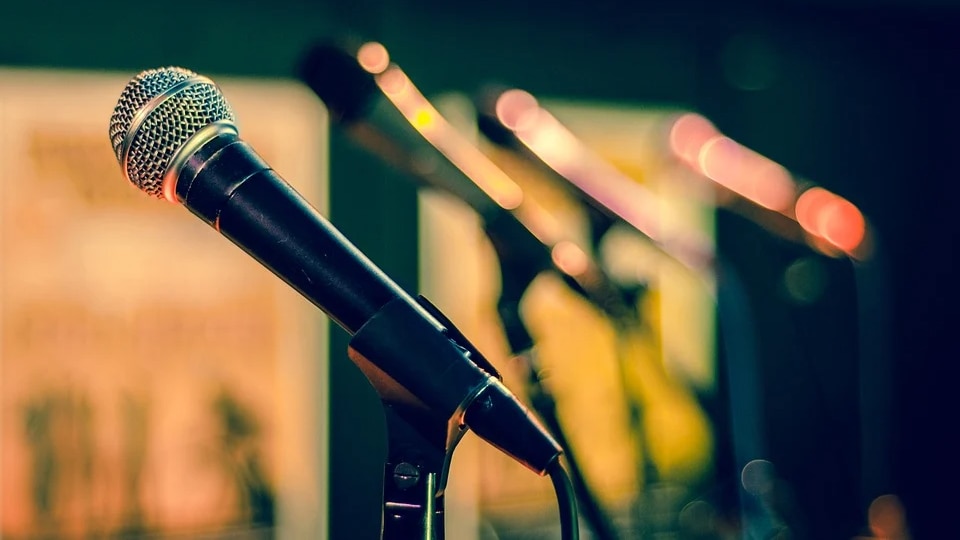By Margaret Jones
Getting out into your community and playing at "open mic" live music events is a great way to hone your performance skills and meet new people, but it can also be intimidating. Here are a few tips for making sure your first visit to an open mic is successful and fun.
Being ready to take the stage begins before you leave the house. Run through the songs you intend to play the way you expect to perform. Will you be standing or sitting? If you're singing, how do you want the microphone positioned? The closer you can get to what you'll do onstage, the more ready you'll be later. If the open mic is popular, you may only get to play one song; some venues let you play two or three. Once you've run through your set, make sure you've packed everything you'll need. Don't forget the little things like picks and a tuner; while it's likely that someone else at the open mic can help you out if you forget anything, it's never fun to scramble to find something when you're about to walk on stage.
![[RS+] Surviving Your First Open Mic - tuner pedal clipon 960](http://staticctf.ubisoft.com/J3yJr34U2pZ2Ieem48Dwy9uqj5PNUQTn/6jyxGE3vcjMmUta1iCGwVj/36fc7d21945495e6af7431d8ddd44226/tuner_pedal_clipon_960.jpg)
From straps to picks to tuners, double-check that everything you need for your set makes it into your gig bag (and has fresh batteries).
Be sure to get to the venue on time so you can sign up for a good time slot. Some venues pull names out of a hat; some offer time slots on a first-come-first-served basis. Make sure you're on the list, then grab a seat, settle in, and wait for the music to start. It can help to keep track of how many people are ahead of you; when the person before you starts their song, it's time to get your guitar tuned and ready to play.
Okay, now it's your turn. Take a deep breath and relax. You've still got a minute or two of setup to settle in and make sure everything sounds good. If you're in a venue with professional sound equipment, there most likely will be an audio engineer to help you set up – and definitely let them help you! If they ask you to turn down an amp or make other adjustments, don't feel offended; it's to make you sound better going through their equipment, and they know how the house sounds. If you are playing "direct" – that is, plugging something like an acoustic guitar directly into the mixing board – don't plug in until the engineer tells you it's okay. If the channel is unmuted, you'll hear the same popping sound you hear plugging into your amp at home, except it will be much, much louder. In addition to startling everyone in the venue, it can permanently damage the venue's equipment, so it's best to avoid that if you can.
![[RS+] Surviving Your First Open Mic - samson direct 960](http://staticctf.ubisoft.com/J3yJr34U2pZ2Ieem48Dwy9uqj5PNUQTn/78848GvjOp8kgn0kUwB7HE/89c6a1ed3fe02317970c0c361e376114/samson_direct_960.jpg)
If you're running direct into the board, you'll most likely plug into a box like this. Pretend it's an amp, and look for the "input" jack.
Finally, enjoy your performance! It's okay to pause and take another deep breath before you start if you're feeling nervous. It's important not to start too fast, especially if you're playing anything technical or difficult; the adrenaline rush that happens in front of an audience almost always makes you want to speed up. Give yourself a second to establish a tempo that feels good, and then go for it! The more relaxed and comfortable you feel when you play, the more your audience will feel it, too.
When you finish your set, be sure to thank everyone for listening and thank the venue for hosting the event. Once again, wait for the engineer to give you a signal that it's okay to unplug from the board, gather your gear so the next person can get ready to play, and then relax and enjoy the feeling of having just played a successful set. If the venue serves refreshments, grab yourself something and settle in to enjoy the rest of the performances. You've earned it!
Margaret Jones is a multi-instrumentalist, songwriter, and music teacher living in Oakland, CA. She plays guitar in several local bands including her own songwriting project M Jones and the Melee. She also holds a Ph.D. in Music History from UC Berkeley and has taught at the San Francisco Conservatory of Music.
Microphone by Skitterphoto is licensed for free use by Pixabay.
Guitar Tuners, Standard and Clip-on by Trude Bergheim Mikkelsen is licensed under CC BY-SA 4.0.
SAMSON S-direct DI-Box by Bene is licensed under CC BY-SA 3.0.
This is just the beginning! Use the powerful practice tools, accurate note detection, and real-time feedback of Rocksmith+ to become the musician you want to be.









